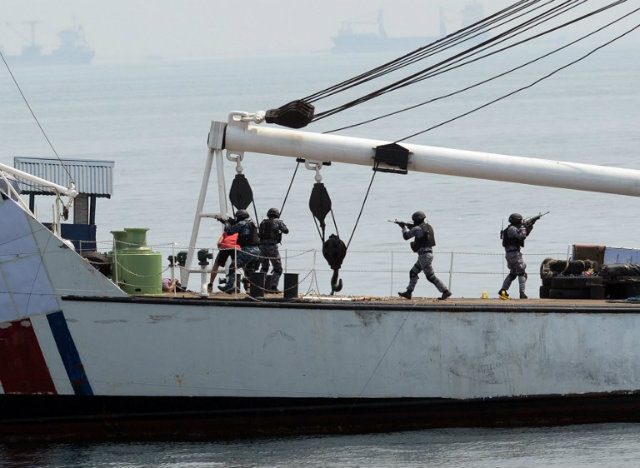SUMMARY
This is AI generated summarization, which may have errors. For context, always refer to the full article.

MANILA, Philippines – Two Japanese destroyers and one of the Philippines’ newest warships began historic naval exercises in the flashpoint South China Sea (West Philippine Sea) on Tuesday, May 12, showcasing a deepening alliance aimed at countering a rising China.
The day-long war games, the first bilateral naval exercises between the former World War II enemies, took place less than 300 km (186 miles) from a Philippine-claimed shoal now under Chinese control.
Philippine authorities insisted the exercises were merely focused on building military capabilities, but security analysts said they were clearly a signal to China over bitter maritime territorial disputes.
“First they demonstrate that China’s Pacific neighbors are beginning to balance against China,” professor Michael Tkacik, a foreign policy expert at the Texas-based Stephen F. Austin State University, told Agence France-Presse.
“Japan, the Philippines, Vietnam, and assorted other states are threatened by China’s behavior, even as far away as India. Thus, the Philippines and Japan are jointly making an important statement about how seriously they view China’s actions.”
China has caused deep concern regionally in recent years as it has become more aggressive in staking its claims to the South China Sea and Japanese-claimed islands in the East China Sea.
China insists it has sovereign rights to nearly all of the South China Sea.
However the Philippines, Vietnam, Malaysia and Brunei have competing claims to parts of the sea, which is vital to the global shipping industry and is believed to contain huge deposits of fossil fuels.
Rising confrontation
In 2012, China took control of Scarborough Shoal, a rich fishing ground within the Philippines’ exclusive economic zone and more than 650 km from the nearest major Chinese landmass.
Chinese coastguard vessels have since guarded the shoal and denied Filipino fishermen access, triggering a series of protests from the Philippines that have been brushed aside in Beijing.
Although the Philippine navy declined to say exactly where Tuesday’s exercises would take place, it said the vessels would sail into the South China Sea from the former US Subic Bay naval base.
That base is about 270 km southeast of Scarborough Shoal.
A Philippine navy spokesman said the exercises were the first bilateral war games between the two nations.
He said one of the main drills would see an AW 109 helicopter from the BRP Ramon Alcaraz, a frigate acquired from the United States in 2012, flying to one of the Japanese destroyers when the 3 vessels meet at sea.
“It would be naive for anyone to think this is just an ordinary joint exercise in the light of some assertive actions by China in the South China Sea,” Wilfrido Villacorta, an international relations lecturer at the Manila-based De La Salle University, told Agence France-Presse.
He described this as a “natural reaction” by the Philippines after recent “provocations”.
Villacorta cited in particular China’s recent flurry of reclamation activities on reefs in the Philippine-claimed Spratlys archipelago, turning them into islands capable of hosting significant military outposts.
The Spratly islands are about 800 km from Subic Bay.
The latest joint exercise will likely be just one more step towards closer cooperation between the Philippines and Japan, said Julius Cesar Trajano, senior analyst of Singapore’s S. Rajaratnam School of International Studies.
“Japan is trying to test the waters (to show) that it is willing to assist its partners in the region,” he told Agence France-Presse.
However, because of legal limits to the military aid it can extend, Trajano said Japanese aid will likely be in the form of training or to non-military institutions like the coast guard.
The Philippine and Japanese coast guards already held exercises in the Philippines earlier this month and Japan has already pledged to provide 10 patrol boats to the Philippine coast guard.
China and Japan are separately engaged in a bitter and longstanding row over ownership of a Japanese-controlled island chain in the East China Sea. They are known as Diaoyu in China and Senkaku in Japan. – Mynardo Macaraig, AFP / Rappler.com
Add a comment
How does this make you feel?
There are no comments yet. Add your comment to start the conversation.